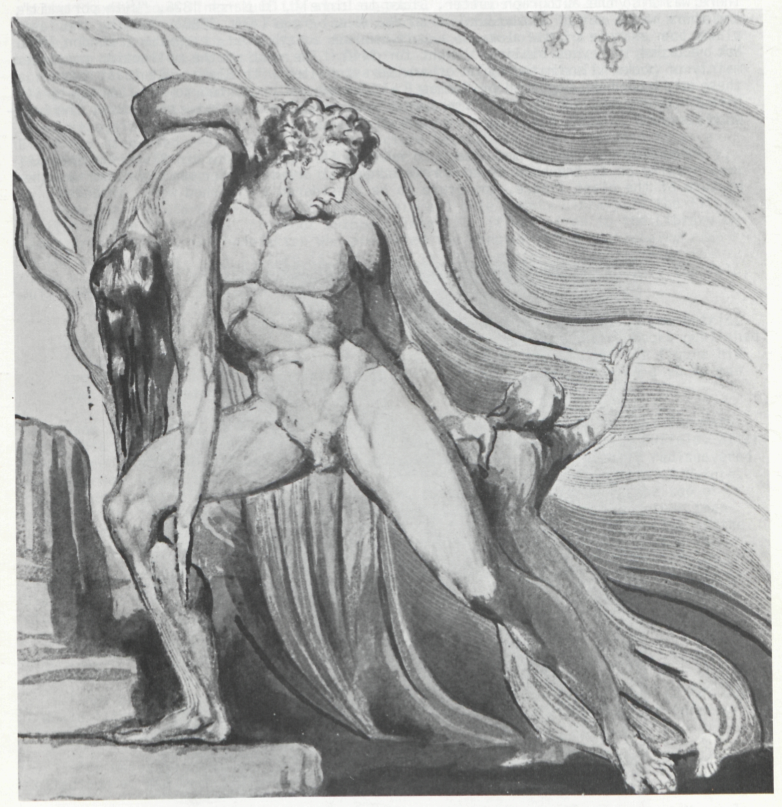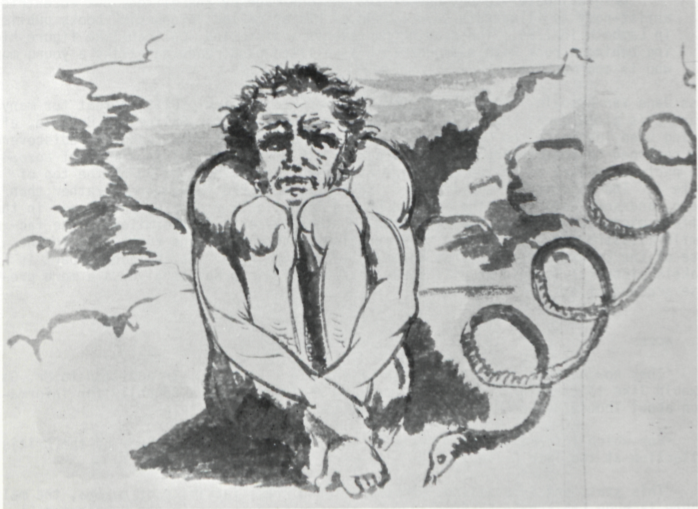note
begin page 81 | ↑ back to topBlakes at Buffalo
While teaching a seminar on Jerusalem in the Buffalo summer session of 1970, I became aware of five Blake pictures the whereabouts of which are virtually unknown to present-day students of Blake. Four of these are in the Lockwood Memorial Library of the State University of New York; one is in the Rare Book Department of the Buffalo and Erie County Library. As these pictures have been lost track of for at least several decades, begin page 82 | ↑ back to top and as at least two of them have never been reproduced, it is appropriate to note their existence here.
I was first informed of the Lockwood Library Blakes by Mr. K. C. Gay, curator of the famous Poetry Collection there. No acquisition record could be found, but the pictures are described in A Selection of Books and Manuscripts in the Lockwood Memorial Library of the University of Buffalo (New York, 1935). At some undetermined time, the pictures were placed in the Library vault, where Mr. Gay came across them last year.1↤ 1 They now hang in the office of the Associate Librarian. In addition to Mr. Gay, I would like to thank Dr. Oscar Silverman and Professor Thomas Connolly for information about Thomas B. Lockwood and his collection. All four items had been sold at auction in New York by the American Art Association on 2-3 April 1928.2↤ 2 For which information I am grateful to Mr. Martin Butlin, Keeper of the British Collection at the Tate Gallery. They were part of a collection owned by Emma W. Bucknell of Philadelphia, and they are described in the sale catalogue as follows:
↤ 3 This statement is puzzling. In the Trianon Press facsimile of Europe, the male figure is nude (this page is from copy B, the Cunliffe copy); in the Huntington Library copy he is nude; and in the proof plate in the Lessing J. Rosenwald collection, he is also nude (this last is reproduced in the Philadelphia Museum of Art’s William Blake 1757-1827/A Descriptive Catalogue of an Exhibition of the Works of William Blake Selected from Collections in the United States, 1939, facing p. 38. In the Keynes-Wolf Census, p. 79, this figure is described as “a nude man . . . .” ↤ 4 The Important Library of / PRESS BOOKS / LIBRARY SETS / FIRST EDITIONS / Formed by the late / Emma W. Bucknell . . . The catalogue cover does not mention Blake, but the title page includes “A Notable Collection of BLAKE ITEMS” and particular note is made of the Blake collection in the foreword. The Blake items take up pp. 10-16 of the catalogue; page 15 is a reproduction of the Laocoön. The Blake section is headed “Extremely Important Series of Blake Items Including Original Drawings / Numbers 56 to 85, Inclusive.”
| [Fig. 1] | Original Watercolor Drawing by Blake for “Europe, A Prophecy” |
| 56. Blake (William). Original Watercolor Drawing of “Shot from the Heights of Enitharmon.” Height: 6 ½ inches; width: 6 ½ inches. Framed between 2 sheets of glass. Circa: 1794. | |
| This is the Final Illustration in Blake’s “Europe, A Prophecy,” Published in 1794. The drawing depicts a nude figure of a man carrying an inanimate woman on his shoulder and dragging a child by the arm; they are flying from a huge tongue of flame. | |
| [Fig. 2] | This drawing is tipped on to a sheet on the back of which is a pencil drawing of a discus thrower, and the name “Mrs. Gilchrist” is written in the right hand margin. |
| There is a slight variation in this drawing and the illustration in “Europe”: the drawing depicts the man entirely nude, and the muscles of his body are clearly depicted, whereas in the illustration as published the muscles of the body are not shown, a cloth is draped across his loins, and the figure of the child is partially obscured by the flames.3 | |
| Important Blake Drawing | |
| [Fig. 3] | 57. Blake (William). Original Wash Drawing of a giant figure, seated on the ground, in a hunched position, head resting on knees, arms entwining legs and hands clasped at ankles; in the background is the blue sky; rocks to each side of figure; in the right hand margin is depicted a snake wending its way down the side of the rock. Height: 7 ½ inches; length, 8 inches. Framed. |
| 58. Blake (William) Beggar’s Opera, Act III. “When My Hero in Court Appears & c.” Line engraving. Painted by Will m Hogarth. Engraved by Wm. Blake. Publish’d July 1, 1790 by J. & J. Boydell, Cheapside . . . London. Height, 24; length 30 inches. In black frame. | |
| The exceedingly rare first state of this engraving, with the following scratched below the plate, — “Painted by Will m Hogarth, 1729. Etch’d by Will’ m Blake, 1788.” No. 71 in A. G. B. Russell’s The Engravings of William Blake. 4 |
In the New York Public Library’s copy of the auction catalogue, sale prices have been marked next to each item. If these figures are correct, number 56 brought the highest price in the Blake section, going for $1,100. Number 57, the wash drawing, begin page 83 | ↑ back to top
Several minor conundrums attach to numbers 56 and 57. Why did Blake tip the Europe drawing on to the back of an unrelated pencil drawing? For what purpose was the picture of the giant figure, too crude to be considered a finished work, intended?
The Blake picture belonging to the Buffalo and Erie County Library is the illustration to the “Preludium” plate of Europe (plate 1). It was given to the Library by James Fraser Gluck, the benefactor who presented the manuscript of Huckleberry Finn to the same library. The picture is described in the Descriptive Catalogue of the Gluck Collection of Manuscripts and Autographs in the Buffalo Public Library (Buffalo, July 1899):
Original water-color, one of the designs made by the gifted, but eccentric, artist-poet to illustrate Europe, one of his so-called “prophetic” books published in Lambeth in 1794. The drawing represents a distorted, Caliban-like figure hiding behind a rock with a dagger in his uplifted hand ready to strike a young man who is approaching.Miss Jane Van Arsdale, librarian of the rare book collection, tells me that for many years this picture was kept in the vault of the Albright-Knox Gallery in Buffalo, after having been loaned to the Gallery for an exhibition; it was only recently rediscovered and returned to the Library. Compared against the Trianon Press facsimile of Europe, the picture appears to be the same size as the corresponding portion of the top of plate 1. The coloration is different: foliage is colored yellow-brown rather than green, and some details of the foliage behind the Pilgrim figure do not appear in the Buffalo picture. However, the latter is in other respects very similar to the facsimile illustration, even in the configuration of shadows on the rocks. As in the case of the Lockwood picture from Europe, it is to be hoped that someone expert in Blake’s pictorial techniques will study this picture in order to give us a more precise account of it. begin page 86 | ↑ back to top



